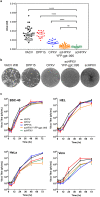Construction of an infectious horsepox virus vaccine from chemically synthesized DNA fragments
- PMID: 29351298
- PMCID: PMC5774680
- DOI: 10.1371/journal.pone.0188453
Construction of an infectious horsepox virus vaccine from chemically synthesized DNA fragments
Abstract
Edward Jenner and his contemporaries believed that his variolae vaccinae originated in horses and molecular analyses show that modern vaccinia virus (VACV) strains share common ancestry with horsepox virus (HPXV). Given concerns relating to the toxicity of modern VACV vaccines, we asked whether an HPXV-based vaccine might provide a superior alternative. Since HPXV may be extinct and the only specimen of HPXV that has been identified is unavailable for investigation, we explored whether HPXV could be obtained by large-scale gene synthesis. Ten large (10-30 kb) fragments of DNA were synthesized based on the HPXV sequence along with two 157 nt VACV terminal sequences, and were recombined into a live synthetic chimeric HPXV (scHPXV) in cells infected with Shope fibroma virus (SFV). Sequencing of the 212 kbp scHPXV confirmed it encoded a faithful copy of the input DNA. We believe this is the first complete synthesis of a poxvirus using synthetic biology approaches. This scHPXV produced smaller plaques, produced less extracellular virus and exhibited less virulence in mice than VACV, but still provided vaccine protection against a lethal VACV challenge. Collectively, these findings support further development of scHPXV as a novel replication-proficient smallpox vaccine.
Conflict of interest statement
Figures





Comment in
-
Public Safety and National Security Implications of the Horsepox Study.Health Secur. 2018 Mar/Apr;16(2):140-142. doi: 10.1089/hs.2018.0018. Epub 2018 Mar 14. Health Secur. 2018. PMID: 29624486 Free PMC article. No abstract available.
References
-
- Fenner F, Henderson A, Arita I, Jezek Z, Ladnyi ID. Smallpox and its eradication. Geneva: World Health Organization; 1988. 1460 p.
-
- Baxby D. Jenner's smallpox vaccine: the riddle of vaccinia virus and its origin. London: Heinemann Educational; 1981.
-
- Medaglia ML, Moussatche N, Nitsche A, Dabrowski PW, Li Y, Damon IK, et al. Genomic Analysis, Phenotype, and Virulence of the Historical Brazilian Smallpox Vaccine Strain IOC: Implications for the Origins and Evolutionary Relationships of Vaccinia Virus. Journal of virology. 2015;89(23):11909–25. doi: 10.1128/JVI.01833-15 - DOI - PMC - PubMed
-
- Tulman ER, Delhon G, Afonso CL, Lu Z, Zsak L, Sandybaev NT, et al. Genome of horsepox virus. Journal of virology. 2006;80(18):9244–58. Epub 2006/08/31. doi: 10.1128/JVI.00945-06 - DOI - PMC - PubMed
-
- Schrick L, Tausch SH, Dabrowski PW, Damaso CR, Esparza J, Nitsche A. An Early American Smallpox Vaccine Based on Horsepox. N Engl J Med. 2017;377(15):1491–2. doi: 10.1056/NEJMc1707600 . - DOI - PubMed
Publication types
MeSH terms
Substances
LinkOut - more resources
Full Text Sources
Other Literature Sources
Research Materials

